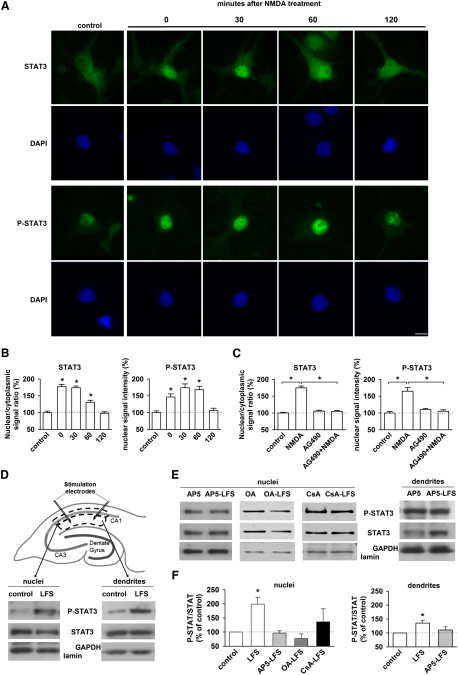Figure 6.
STAT3 Is Activated and Translocated to the Nucleus during NMDAR-LTD
(A) STAT3 and P-STAT3 (Tyr 705) immunoreactivity in the cytoplasm and nuclei of hippocampal neurons in culture. NMDA treatment (20 μM, 10 min) induces an increase of both STAT3 and P-STAT3 immunoreactivity in neuronal nuclei, 0, 30, and 60 min after NMDA treatment. Scale bar: 10 μm.
(B) The graphs show that the nuclear/cytoplasmic STAT3 signal ratio and the P-STAT3 signal intensity are significantly increased at these times, compared with control values.
(C) AG490 (10 μM) pretreatment prevents the NMDA-induced increase of nuclear STAT3 and P-STAT3 immunoreactivity.
(D) After delivering LFS, the stratum radiatum surrounding the stimulating electrodes (dendrites) or the stratum pyramidale (CA1 cells bodies) close to the stimulated area were microdissected. The nuclei from the cell bodies were isolated by centrifugation. The blots of P-STAT3 and STAT3 show that the phosphorylation of STAT3 was increased in both compartments. Lamin and GAPDH were used as a blotting control for the nuclei and dendrites, respectively.
(E) The blots show that no activation of STAT3 is observed when the slices are treated with AP5 (50 μM, 45 min), okadaic acid and cyclosporin A (as in Figures 4F and 4G) prior and during LFS.
(F) Graphs summarizing the data obtained in (D) (n = 14) and (E) (n = 10 for AP5 and n = 5 for okadaic acid and cyclosporin A).

